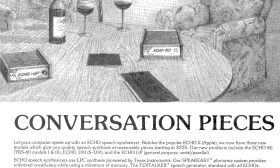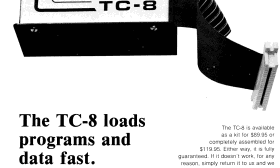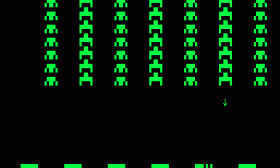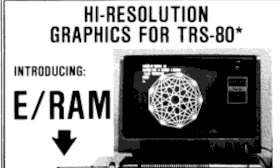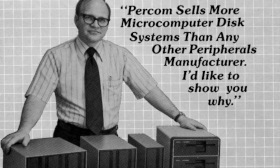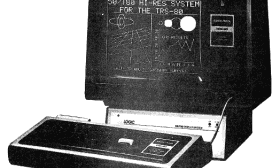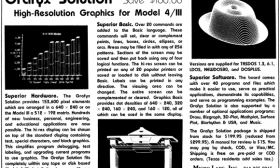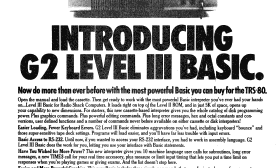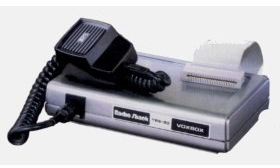Street Electronics Corporation sold a variety of speech synthesizers with the Echo name. The Echo II, the Apple II version, was the most popular, but they also sold versions for other computers. As of 1982, there were four versions:
- Echo-80 for the TRS-80 Model I and III
- Echo II for the Apple II
- ECHO-100 for S-100 computers
- ECHO GP (General Purpose) for any computer with a RS-232 or parallel printer port (including a TRS-80)
(Read more...)
The TC-8 Cassette System was a hardware add-on from JPC Products that provided faster and more reliable cassette storage for the TRS-80 Model I. Advertised as “The Poor Man’s Floppy”, the TC-8 provided features similar in many ways to the Exatron Stringy Floppy. The TC-8 could store up to 300K on an single 30 minute cassette tape. It increased the standard TRS-80 cassette data rate from 500 baud to nearly 3000 baud. It also promised much greater reliability, “less than one bad load in a million bytes.”
The TC-8 was derived from the TC-3, a similar cassette system that JPC Products created in 1978 for 6800 computers. When introduced in 1980, the TC-8 cost $69.95 for a kit and a $99.95 for a fully assembled version. Those prices soon increased to $89.95 for the kit and $119.95 for the fully assembled version. The JPC Products advertisements recommended that buyers consider the kit version, saying:
(Read more...)
Space Colony was a TRS-80 adaptation of the 1978 Taito arcade game hit Space Invaders. It was written by Kim Watt and sold through his own company, Breeze Computing. Kim Watt was better known in the TRS-80 world for his disk utility, Super Utility. Some sources say that Space Colony was also distributed by Adventure International, but I haven’t found it listed in any catalog.
Interestingly, Space Colony wasn’t the first version of Space Invaders that Kim Watt wrote for the TRS-80. He had earlier written Invaders, a game distributed by Level IV Products. Space Colony was a good rendition of Space Invaders and had superior graphics and game play to Invaders. But it had one very unusual feature: it was one of the few commercial high-resolution Model I games.
(Read more...)
The E/RAM was a high-resolution add-on for the TRS-80 Model I. Introduced in 1980 for a price of $349.95, the E/RAM was designed and manufactured by Keyline Computer Products from Tulsa, Oklahoma. It was sold by Vern Street Products, also in Tulsa.
The E/RAM (an acronym for Extended Random Access Memory) contained 6K of video memory. It increased the TRS-80 graphics resolution to 256 by 192, with the high-resolution graphics overlaying the text screen. The graphics could be enabled and disabled using either software or a hardware switch.
The E/RAM came in a steel case measuring 2 1/2″ high, 6″ wide, and 12″ deep. The self-contained unit sat next to the Model I and installed in a straightforward way:
(Read more...)
Percom Data is one of the best remembered TRS-80 hardware companies. Percom Data and its founder Harold Mauch were responsible for many of the most important TRS-80 hardware products, including the Percom Separator and the Percom Doubler.
Percom had its origins in a symposium sponsored by BYTE magazine in November 1975. That event, held in Kansas City, Missouri, was about the “interchange of data on inexpensive consumer quality audio cassette drives.” The eighteen attendees (including Bill Gates) created a cassette storage format that became known as the “Kansas City Standard.” The final standard, published in the February 1976 issue of BYTE, was written by Lee Felsenstein and Harold Mauch. Harold Mauch also wrote an article, “Digital Data on Cassette Recorders” that was published in the March 1976 issue of BYTE.
(Read more...)
Unlike many competing computers, the TRS-80 Model I lacked any form of built-in high-resolution graphics. Although some TRS-80 compatible computers, such as the LNW80, offered high-resolution as a feature, the only graphics possible with the Model I were relatively low-resolution 128 by 48 block graphics. The many games written for the Model I made good use of these block graphics, and Radio Shack never made high-resolution a standard feature of the Model I, III, or 4. Several companies created products to address this deficiency, with some becoming more popular than others.'
(Read more...)
The SubLOGIC 50/T80 was a high-resolution add-on for the TRS-80 Model I. It was created by SubLOGIC, a company better known to TRS-80 users for their T80-FS1 Flight Simulator.
Here is the text of the 1980 product introduction:
The SubLOGIC 50/T80 system is a high performance professional graphics display system designed to be used directly with the TRS-80. It provides the high-resolution graphics capability which the 80 lacks—the kind of graphics needed for scientific, engineering, and educational applications. Dense drawings, graphs, and even alphanumerics can be put on the 50/T80’s 256 by 240 dot screen. The 50/T80 has the support of SubLOGIC’s 2D and 3D graphics packages, which are powerful and easy to use. They operate easily from BASIC as well as assembly language.
(Read more...)
The Model 4 Grafyx Solution was the most popular high-resolution add-on for the TRS-80 Model 4, and probably the most popular Model 4 add-on in general. It was introduced in 1984 for a price of $199.95 by Micro-Labs, creators of the earlier Model III Grafyx Solution. The Model 4 Grafyx Solution provided true high-resolution access to every pixel on the 640 by 240 Model 4 display, yet was easily user-installable in only a few minutes.
Unlike the Model III Grafyx Solution, which was memory mapped, the Model 4 Grafyx Solution was port-mapped. It used the same ports and mapping as the Radio Shack Model 4 high-resolution board. This meant that the Model 4 Grafyx Solution was almost completely compatible with the Radio Shack board and they could run the same programs. This had the odd side effect of making the Model 4 Grafyx Solution in Model III mode incompatible with the Model III Grafyx Solution.
The Model 4 Grafyx Solution had many advantages compared to the Radio Shack board:
(Read more...)
Level III BASIC was an enhanced version of Level II BASIC for the TRS-80 Model I. It was created by Microsoft, also the authors of Level II BASIC, but sold by GRT Corporation on cassette for $49.95. Level III BASIC was said to be the first consumer product from Microsoft, which had previously sold only to manufacturers.
Rather than sell Level III BASIC directly to consumers, Microsoft decided to release it through GRT Corporation in 1978. GRT Corporation, which stood for Great Records and Tapes, was a music company that had expanded into the software business. The GRT software division, named G2, was started by Vern Raburn and Level III BASIC was sold under the G2 label.
The Level III BASIC manual contains this surprising statement of authorship:
(Read more...)
The TRS-80 VOXBOX (catalog number 26-1181) was an early microcomputer speech-recognition product for the TRS-80 Model I. Introduced in July 1979 by Radio Shack for a price of $169.95, the VOXBOX was described as “electronic ears for your Model I.” The VOXBOX was only available for the Model I; there never was a version for the Model III.
Here is a description of the VOXBOX from a 1980 Radio Shack catalog, where it was paired with the $399 TRS-80 Voice Synthesizer:
(Read more...)
